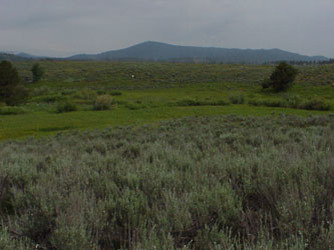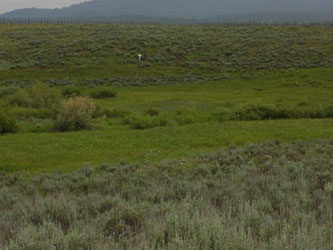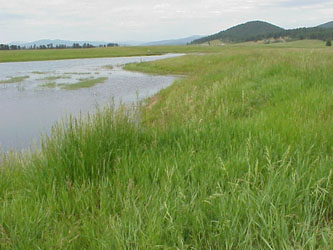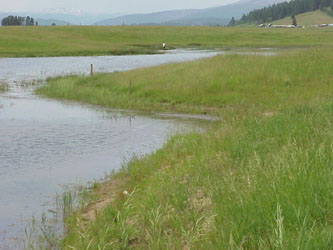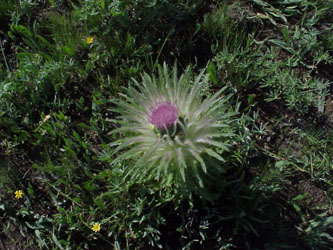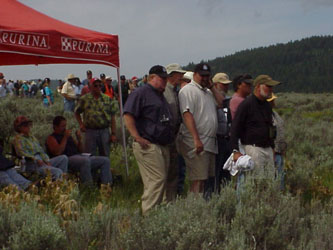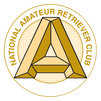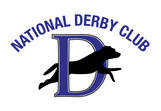Thursday, June 19, 2003 |
Land Blind
Last night's showers had ended and another clear day arrived. Temperatures were in the low 50's with a forecast of afternoon showers and temperatures in the low 90's There was little wind.
The 5th resumed as scheduled with a single test dog at 7:30 and the first running dog #56 on line art 8 a.m. There was a slight haze over the bowl and dew on the grass.
Conditions were about the same as the previous day - perhaps a little worse. Again, there were several handles and two pick ups. It ended at 10:15 with dog 77.
Callbcks came within 15 minutes and only 42 remained. 25 had been lost. The fifth had taken a serious toll. Those dropped were: 3, 4, 5, 11, 15, 19, 25, 27, 28, 31, 33, 26, 43, 56, 63, 66, 67, 72, 74, 84, 96, 97, 98, 101, and 103.
The Sixth series, a land blind through the previous marks, was quickly organized. The line was moved about 60 yards to the left and a cock pheasant was placed on the far hill about 200 yards away (est.) . The line to it passed tightly to the right of the middle mark. The wind angled back from left to right across the site.
The first test dog arrived and about 10:55 with the second a few minutes late. It appeared to be a very do-able test. The first running dog, #10 stepped to line at 11:10.
The line was above the sagebrush ring and continued down the hill through the brush lined creek(s) below and skimmed the heavier cover and old mark to the left, where they could easily be lost. Beyond was more sagebrush and the hillside where the bird lay marked by a patch of taller grass. It took only 2-3 minutes to complete.
As the test was running, an announcement was made that there would be a move afterwards. A water blind was rumored for the 7th. Callbacks would be given at the present site.
Dogs would try to either go back to the middle mark (path) or drive to the hill between that one and the flyer station (crates still in the field). Others would refuse casts away from the diversions or drive up the hill toward the old left mark.
The test was completed at 1:48 with dog 9. As he left the line, lightning and thunder rolled across the mountains behind the site. It had been partly cloudy with a few sprinkles, but a nasty one was rolling in. As cars lined up for the caravan to the new site, it rained. Call backs were given and only 2 dogs, 39 and 52 had been dropped, leaving 40 for the Seventh series water blind.
It took about 45 minutes to get to the new site again at Paddy Flats road on the other end ot town.
There, a shoreline blind was being organized on the far edge of a large pond. There were 7 decoys just off line in the water to the left and several more just around the corner to the left of the next large point
The 5th resumed as scheduled with a single test dog at 7:30 and the first running dog #56 on line art 8 a.m. There was a slight haze over the bowl and dew on the grass.
Conditions were about the same as the previous day - perhaps a little worse. Again, there were several handles and two pick ups. It ended at 10:15 with dog 77.
Callbcks came within 15 minutes and only 42 remained. 25 had been lost. The fifth had taken a serious toll. Those dropped were: 3, 4, 5, 11, 15, 19, 25, 27, 28, 31, 33, 26, 43, 56, 63, 66, 67, 72, 74, 84, 96, 97, 98, 101, and 103.
The Sixth series, a land blind through the previous marks, was quickly organized. The line was moved about 60 yards to the left and a cock pheasant was placed on the far hill about 200 yards away (est.) . The line to it passed tightly to the right of the middle mark. The wind angled back from left to right across the site.
The first test dog arrived and about 10:55 with the second a few minutes late. It appeared to be a very do-able test. The first running dog, #10 stepped to line at 11:10.
The line was above the sagebrush ring and continued down the hill through the brush lined creek(s) below and skimmed the heavier cover and old mark to the left, where they could easily be lost. Beyond was more sagebrush and the hillside where the bird lay marked by a patch of taller grass. It took only 2-3 minutes to complete.
As the test was running, an announcement was made that there would be a move afterwards. A water blind was rumored for the 7th. Callbacks would be given at the present site.
Dogs would try to either go back to the middle mark (path) or drive to the hill between that one and the flyer station (crates still in the field). Others would refuse casts away from the diversions or drive up the hill toward the old left mark.
The test was completed at 1:48 with dog 9. As he left the line, lightning and thunder rolled across the mountains behind the site. It had been partly cloudy with a few sprinkles, but a nasty one was rolling in. As cars lined up for the caravan to the new site, it rained. Call backs were given and only 2 dogs, 39 and 52 had been dropped, leaving 40 for the Seventh series water blind.
It took about 45 minutes to get to the new site again at Paddy Flats road on the other end ot town.
There, a shoreline blind was being organized on the far edge of a large pond. There were 7 decoys just off line in the water to the left and several more just around the corner to the left of the next large point
Water Blind
The line was up on the dike facing the irregular shore. To recover the bird, dogs had to angle down the steep right shore for a short distance and enter the water. The line continued through a small bay , across a wide point and into the water behind. Beyond was a stretch of running, then swimming water to a grassy point protruding to the right from the far shore. (It was scented every 10 dog as was the first.) Once across or next to the point, they re-entered the water and swam to the shore beyond where the duck lay 200+ yards from line on a grassy hummock. There was a pick up point to the right of the line.
At 3:52 the test dogs demonstrated the test with little serious trouble. The first competing dog #24, came to line at about 4:30. However, as the test dogs completed, a gusty wind rose. It angled from left to right across the site and did affect the contestants.
The line was difficult to get and maintain throughout the changes of cover and water. Dogs had to be handled away from the water, then toward it while crossing the scented first point. took about 7-8 mpd to complete. Many appeared to have trouble at the end as there was running water to the left.
There they could not hear the whistles or tried to hunt the bird.
It was partly cloudy with some light rain interspersed with brief sunny periods. However, by 8:30 dark clouds rolled in and made the end even more difficult ot see. At 8:55, after dog 6 ran, the test was suspended until Friday. The first running dog, #9 would run at 7:30 a.m. No partial call backs would be given.
At 3:52 the test dogs demonstrated the test with little serious trouble. The first competing dog #24, came to line at about 4:30. However, as the test dogs completed, a gusty wind rose. It angled from left to right across the site and did affect the contestants.
The line was difficult to get and maintain throughout the changes of cover and water. Dogs had to be handled away from the water, then toward it while crossing the scented first point. took about 7-8 mpd to complete. Many appeared to have trouble at the end as there was running water to the left.
There they could not hear the whistles or tried to hunt the bird.
It was partly cloudy with some light rain interspersed with brief sunny periods. However, by 8:30 dark clouds rolled in and made the end even more difficult ot see. At 8:55, after dog 6 ran, the test was suspended until Friday. The first running dog, #9 would run at 7:30 a.m. No partial call backs would be given.

